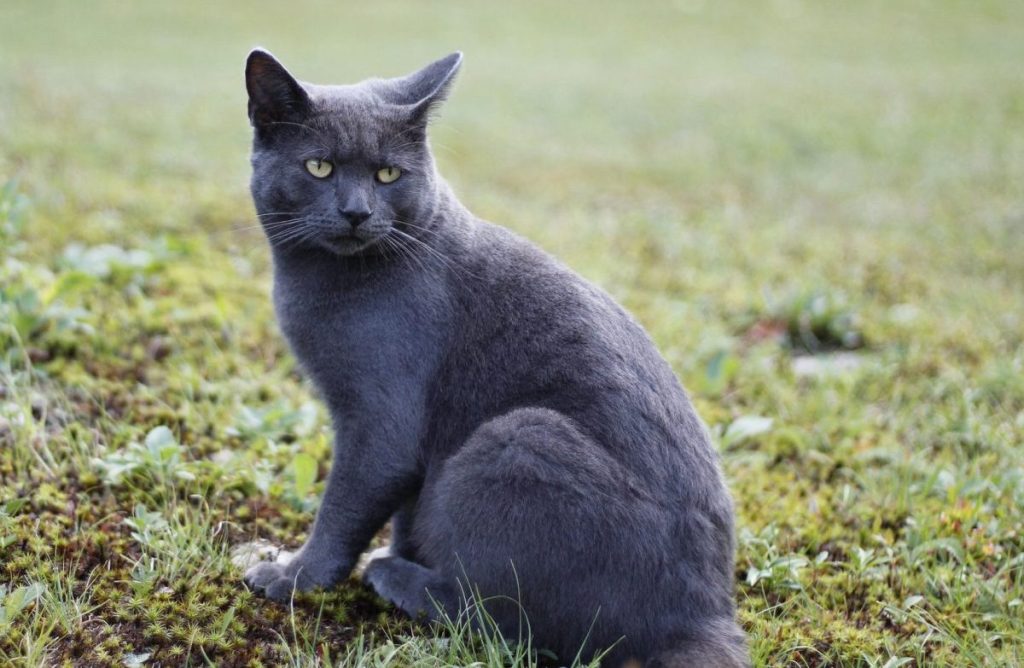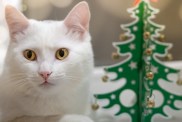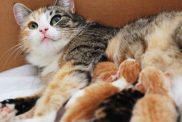The Raas cat (or Madurese cat) is an exotic and purebred breed indigenous to Raas Island in Indonesia. With a bent tail tip that is common in Asian breeds, they have a variety of colors including black and lilac, with the highly-prized blue coats known as Busok cats, and the rare cinnamon-colored coats known as Amethyst cats.
Although the Raas cat is fiercely protected by the local population in order to maintain the breed’s purity, their domestication is best suited for experienced pet parents due to their strong will and natural fear of humans.
In 2022, the Busok cat was recognized by the World Cat Federation (WCF) as the native breed of the neighboring Madura Island, per The Jakarta Post. According to the publication, regular inbreeding occurred for centuries due to their geographic isolation as locals believe any ship attempting to remove these cats from the island would sink.
Raas Cat Characteristics
- Origin: Indonesia
- Size: Medium to Large
- Breed Group: Domestic Shorthair
- Lifespan: 12-15 years
- Coat: Short, dense, and sleek.
- Temperament: Intelligent, playful, energetic, strong-willed, independent, loyal, protective
- Exercise Needs: High
- Training: Requires patience and experienced owners due to their independent nature
- Grooming: Weekly brushing
- Health: Generally healthy, but some potential for genetic health conditions
-
Affectionate with Family
Some cat breeds are typically independent and aloof, even if they’ve been raised by the same person since kittenhood; others bond closely to one person and are indifferent to everyone else; and some shower the whole family with affection. Breed isn’t the only factor that goes into affection levels; cats who were raised inside a home with people around feel more comfortable with humans and bond more easily.

See Cats Less Affectionate with Family -
Amount of Shedding
If you’re going to share your home with a cat, you’ll need to deal with some level of cat hair on your clothes and in your house. However, shedding does vary among the breeds. If you’re a neatnik, you’ll need to either pick a low-shedding breed or relax your standards. This furniture cover can make it easier to clean up cat hair and keep it off your sofa!
-
General Health
Due to poor breeding practices, some breeds are prone to certain genetic health problems. This doesn’t mean that every cat of that breed will develop those diseases; it just means that they’re at an increased risk. If you’re looking only for purebred cats or kittens, it’s a good idea to find out which genetic illnesses are common to the breed you’re interested in.
-
Potential for Playfulness
Some cats are perpetual kittens—full of energy and mischief—while others are more serious and sedate. Although a playful kitten sounds endearing, consider how many games of chase the mouse-toy you want to play each day, and whether you have kids or other animals who can stand in as playmates. A classic wand cat toy like this one is perfect for playful felines!
-
Tendency to Vocalize
Some breeds sound off more often than others with meows, yowls, and chattering. When choosing a breed, think about how the cat vocalizes and how often. If constant “conversation” drives you crazy, consider a kitty less likely to chat.
-
Kid-Friendly
Being tolerant of children, sturdy enough to handle the heavy-handed pets and hugs they can dish out, and having a nonchalant attitude toward running, screaming youngsters are all traits that make a kid-friendly cat. Our ratings are generalizations, and they’re not a guarantee of how any breed or individual cat will behave; cats from any breed can be good with children based on their past experiences and personality.
-
Friendly Toward Strangers
Stranger-friendly cats will greet guests with a curious glance or a playful approach; others are shy or indifferent, perhaps even hiding under furniture or skedaddling to another room. However, no matter what the breed, a cat who was exposed to lots of different types, ages, sizes, and shapes of people as a kitten will respond better to strangers as an adult.
-
Easy to Groom
Some breeds require very little in the way of grooming; others require regular brushing to stay clean and healthy. Consider whether you have the time and patience for a cat who needs daily brushing. You should definitely pick up this awesome de-shedding tool for cats of any hair length!
-
Intelligence
Some cat breeds are reputed to be smarter than others. But all cats, if deprived the mental stimulation they need, will make their own busy work. Interactive cat toys are a good way to give a cat a brain workout and keep them out of mischief. This scratcher cat toy can keep your smart kitty busy even when you’re not home!
-
Pet Friendly
Friendliness toward other household animals and friendliness toward humans are two completely different things. Some cats are more likely than others to be accepting of other pets in the home.
Raas Cat History
The history of the Raas cat starts on Raas Island in Indonesia, the place where the breed’s name derives from. The breed is held in very high esteem by the locals. One myth about the cat claims that they posses a sixth sense and can only be picked up by select members of society.
Another instance of local lore says that anyone taking a Raas cat from the island will be cursed with bad luck! These days, you can find Raas in shelters or in the care of rescue groups. So make sure to consider adoption if you decide that this is the breed for you!
Raas Cat Size
The Raas is a large cat. As is always the case, exact size standards might vary.
Most Raas weigh in at 15 pounds.
Raas Cat Personality
There’s no denying that the Raas breed is a headstrong and sometimes stubborn feline. This is a cat that has hunting and survival roots and will often seem wary or suspicious of humans at first. You’ll need to put in work to bond with your Raas cat–but once you do, it’s a guarantee that you’ll become totally smitten with their sweet and loyal side.
Befitting such a large and powerful cat, the Raas enjoys physical activity and definitely needs to be challenged to stay healthy and satisfied–along with adding cat trees and safe scalable furniture to its environment, smart and interactive toys are a must.
Just remember that the Raas breed is very strong-willed and sometimes a little intolerant–so if the cat seems to be showing you physical signs that it is not happy with you, make sure to give it a little space and time alone.
Raas Cat Health
Raass are generally considered to be healthy cats–although it’s important to schedule regular wellness visits with your cat’s vet. There aren’t any breed-specific health problems associated with the Raas, but always keep an eye out for signs that your cat might be in distress or pain.
Raas Cat Care
As with all cats, it’s important to keep up your Raas’s regular veterinary checkups to detect any health concerns early. Your vet can help you develop a care routine that will keep your cat healthy.
Beyond scheduling yearly wellness visits with your vet, make sure that you pick up a scratching post for your Raas cat’s living environment–this can help promote healthy scratching and keep the cat’s nails in good condition, which is especially important for such a physical and active breed as the Raas.
The cat’s ears should be examined regularly for signs of dirt building up or possible infection. Talk to your vet about starting a regular teeth brushing regime that will suit your Raas. Your vet can advise you about specific brands and techniques–although if the Raas is not tolerant of the process, do not force things.
Finally, because the Raas is a cat with a high amount of energy, it’s recommended that you add at least one cat tree to your home–and if you can provide safe enclosed outdoor space, all the better.
Raas Cat Coat Color And Grooming
The Raas is a cat that is usually either one color or a mix of two, often coming in shades including blue, gray and black. When it comes to grooming, the short-haired Raas cat can be brushed once a week. This will help ward off the chances of any mats forming. Although ask your vet for tips if you find that your Raas doesn’t take to sitting still and being brushed at first. In terms of climate, most Raas cats are fairly adaptable felines. Just remember to always make sure that there’s enough shade and fresh water available during the hotter months.
Children And Other Pets
The Raas cat is best suited to people and families with previous experience being around cats, especially as it’s a breed that can take time to adjust to new people in its life. Young children might annoy the cat–definitely make sure that early socialization takes place and boundaries are properly set on both sides.
The Raas’s hunting heritage means that it might view other smaller domestic animals as prey–so this is probably not the best cat for a household with existing resident pets. Ultimately, in cases involving both kids and other pets, early socialization really pays off with this breed. Make sure to reward your Raas for good behavior when you bring them home to your family!
Raas Cat Rescue Groups
Due to the rarity of this breed, it is unlikely you will find one in a shelter. However, you can always keep an eye out.
More Info For You
If you’re also looking for a dog, check out DogTime’s dog breed page!





